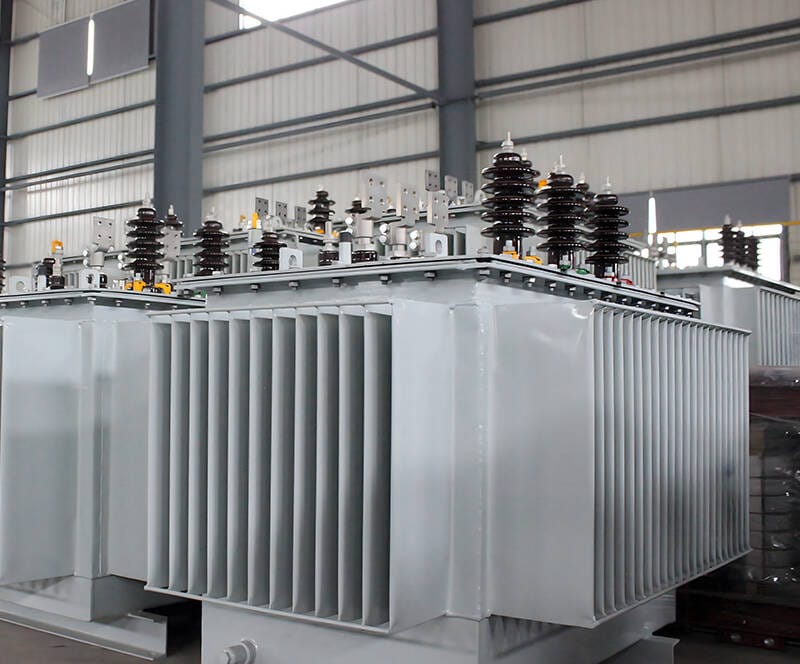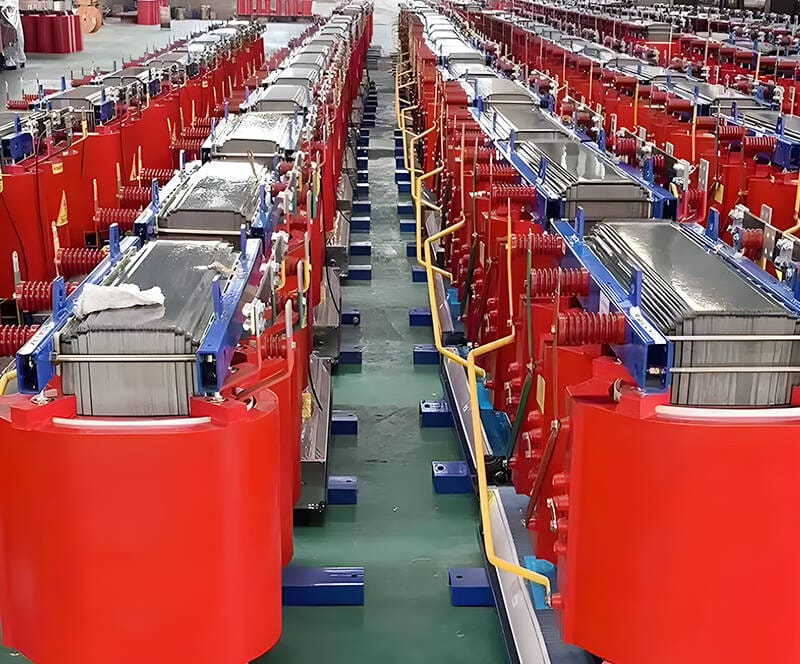I. Introduction
In modern power distribution systems, efficiency, reliability, and safety are the three pillars that determine a project’s success. As global energy demand continues to rise—especially with the rapid expansion of renewable energy and industrial electrification—traditional substation models are being replaced by more compact, modular, and intelligent solutions. Among these innovations, the Box Type Substation Transformer has become one of the most preferred choices for power engineers, EPC contractors, and industrial users around the world.
A Box Type Substation Transformer, also known as a prefabricated substation ou compact substation, is an integrated power distribution unit that combines a high-voltage switchgear, transformer, and low-voltage distribution equipment into a single, enclosed structure. This “plug-and-play” design not only simplifies installation and maintenance but also ensures high safety standards and stable power supply even in demanding environments.
Unlike traditional substations that require large spaces and complex on-site assembly, the box-type substation offers modular design, flexible deployment, and superior protectionagainst harsh weather, dust, and electrical faults. It is widely used in solar farms, wind power stations, industrial plants, residential communities, and construction sites, where quick installation and reliable power delivery are essential.
With the growing trend toward clean energy and distributed generation, European-style Box Type Substation Transformersare becoming the backbone of modern power infrastructure. They deliver not only electrical transformation but also system optimization—offering a cost-effective and future-ready solution for projects of all scales.
In the following sections, we’ll explore in detail what a Box Type Substation Transformer is, how it works, its advantages over the American type, and how to choose the right one for your specific application.

II. What Is a Box Type Substation Transformer?
1.Box Type Substation Transformer: Integrated, Compact Solutions for Efficient and Safe Power Distribution
UN Box Type Substation Transformeris a compact, prefabricated power distribution unit designed to convert and distribute electrical energy safely and efficiently. It integrates three essential components—high-voltage switchgear, distribution transformer, and low-voltage switchgear—within a single, weatherproof metal enclosure. This design eliminates the need for complex civil engineering work and long installation time, making it a popular solution for modern power systems that require quick deployment and minimal maintenance.
Structurally, a typical European-style box substation consists of three independent compartments:
- High-Voltage (HV) Compartment– This section receives power from the grid or an upstream line, equipped with load switches, circuit breakers, fuses, and surge arresters for system protection and isolation.
- Transformer Compartment– The heart of the system, housing either an oil-immersed or dry-type transformer that steps down the high voltage to the desired low-voltage level.
- Low-Voltage (LV) Compartment– Responsible for distributing power to downstream loads through circuit breakers, busbars, and monitoring devices, ensuring stable output and operational safety.
2.European Box Type Substation Transformateur: Robust Construction, Modular Design & Key Applications
The enclosures are typically made of galvanized steel or aluminum alloy, offering excellent corrosion resistance and thermal performance. Depending on the project’s needs, box substations can be customized for different voltage classes—commonly 11kV/0.4kV, 33kV/0.4kV, or even higher for industrial and renewable energy applications.
One of the key reasons for their popularity is the modular and plug-in design. Each unit is fully assembled and tested in the factory before shipment, which drastically shortens on-site installation time and reduces construction risk. The result is a ready-to-use substationthat can be commissioned within days instead of weeks.
Thanks to this integrated and standardized approach, box-type substations are not only compact and efficient but also ensure high operational reliability. They have become an indispensable part of urban distribution networks, solar PV plants, wind farms, and infrastructure projects, where performance, safety, and adaptability are critical.
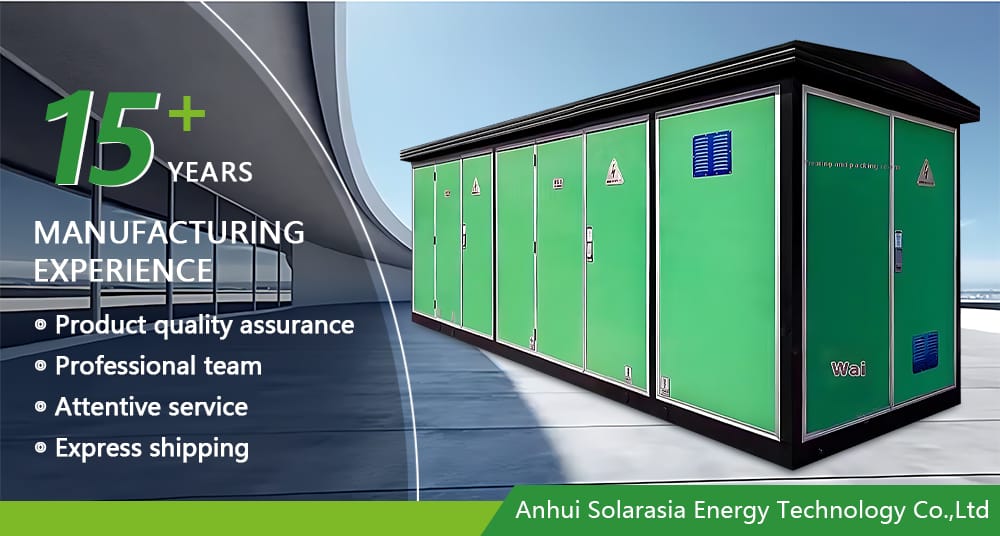
III. Working Principle of Box Type Substation Transformer
Le Box Type Substation Transformeroperates as a complete, enclosed power transformation and distribution system. Its main function is to convert medium-voltage electricity from the utility grid (typically 6–35kV) into low-voltage electricity (usually 400/415V) that can be safely used by end users such as factories, residential buildings, and renewable energy systems. Unlike a conventional open substation, the box-type substation integrates all necessary electrical components into a single, compact enclosure, ensuring safety, reliability, and efficiency.
1.High-Voltage Input and Primary Protection
The power supply enters the box substation through the High-Voltage (HV) Compartment. This section is responsible for receiving medium-voltage electricity from the main distribution line or transformer yard and providing the first layer of system protection. Key components include:
- High-voltage load switch– Allows safe connection and disconnection of the incoming power line.
- Circuit breakers and fuses– Provide short-circuit and overload protection to prevent equipment damage.
- Lightning arresters (surge protectors)– Absorb transient voltage spikes caused by lightning or switching surges.
- Earthing system– Safely discharges fault current into the ground to prevent electric shock and fire.
When the HV side is energized, power is transmitted to the transformer through insulated cables or busbars. The design ensures full isolation between the high-voltage and low-voltage circuits, significantly improving the operational safety of the entire substation.
2.Voltage Transformation: The Core of the System
At the heart of the box substation lies the distribution transformer, which performs the voltage transformation function. The basic working principle follows the law of electromagnetic induction: when alternating current passes through the primary winding, it generates a magnetic field that induces voltage in the secondary winding, thus converting high voltage to low voltage.
Depending on the installation environment and performance requirements, there are two main types of transformers used in box substations:
- Oil-Immersed Transformer:
The windings and core are immersed in mineral or vegetable insulating oil. The oil serves both as an insulation medium and a coolant, transferring heat away from the core and windings to maintain optimal operating temperature. This design is ideal for outdoor and high-capacity applications where efficient cooling and long service life are priorities. - Dry-Type Transformer:
The core and windings are coated or cast with epoxy resin insulation, eliminating the need for oil. Dry-type transformers are safer for indoor environments, urban areas, or places requiring higher fire protection standards. They are quieter and more environmentally friendly, though less suitable for very high-power systems compared to oil-immersed models.
In operation, the primary winding (connected to the high-voltage input) generates a magnetic flux that passes through the core and induces a proportional voltage in the secondary winding (connected to the low-voltage output). Through this process, the transformer ensures a stable, safe, and efficient conversion of electrical energy.

3.Low-Voltage Output and Power Distribution
After the voltage is reduced to the desired level, the Low-Voltage (LV) Compartmentdistributes electricity to downstream loads or local networks. This section includes:
- Low-voltage circuit breakers– Control and protect outgoing feeders.
- Busbars– Distribute current evenly among multiple outgoing circuits.
- Meters and monitoring systems– Measure voltage, current, and power consumption for precise management.
- Capacitor banks or compensation devices (optional)– Improve power factor and reduce energy loss.
From this compartment, power is sent to industrial equipment, lighting systems, or public facilities through cables or overhead lines, depending on the installation environment.
4.Cooling, Ventilation, and Safety Design
Efficient heat dissipation is essential for the continuous operation of a box-type substation. The enclosure is typically equipped with natural or forced air ventilation, heat exchangers, or oil circulation cooling systems. Temperature sensors, oil-level gauges, and pressure relief valves continuously monitor the internal condition of the transformer to prevent overheating or insulation breakdown.
Additionally, all compartments are metal-enclosed and grounded, ensuring operator safety and protection from electric arcs. The internal partitions between the HV, transformer, and LV sections prevent cross-contamination of electrical faults, while fire-resistant and weatherproof materials extend the lifespan of the equipment even under extreme outdoor conditions.
5.Intelligent Monitoring and Automation
Modern Box Type Substation Transformers can be integrated with SCADA (Supervisory Control and Data Acquisition)ou IoT-based remote monitoring systems. Through real-time sensors, operators can track vital parameters such as load current, oil temperature, humidity, and insulation condition. Early fault detection enables predictive maintenance, minimizing downtime and extending equipment lifespan.
These smart systems make box substations not just passive transformers, but active participants in smart grid networks, capable of communicating operational data and optimizing power flow dynamically.
6.Summary of Working Process
- Power Input:High-voltage electricity enters the substation through HV cables and switchgear.
- Voltage Step-Down:The transformer converts high-voltage power (e.g., 11kV) to low-voltage (e.g., 400V).
- Power Distribution:The LV switchgear distributes the transformed electricity to local users.
- Monitoring & Protection:Built-in systems ensure stable performance, safety, and efficient energy utilization.
In conclusion, the working principle of a Box Type Substation Transformer integrates electromagnetic transformation, multi-level protection, efficient cooling, and intelligent controlwithin a single, compact unit. This holistic approach provides safe, reliable, and sustainable power for diverse applications—from industrial complexes and renewable energy stations to modern urban infrastructure.
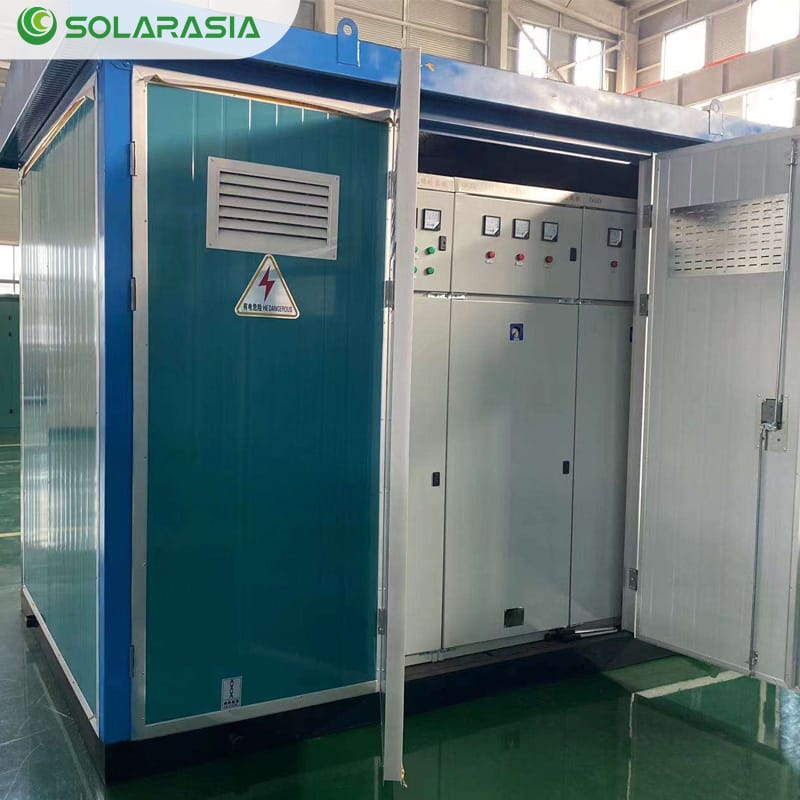
IV. Difference Between European and American Box Type Substation
Although both Europeanand American Box Type Substation Transformersserve the same purpose—transforming and distributing electricity safely—their designs, construction philosophies, and operational performance differ greatly. These differences reflect the engineering traditions and application environments of each region. Understanding them helps engineers and project owners select the most cost-effective and technically suitable substation for their projects.
1.Structural Design Philosophy
European Box Type Substation (Split-Compartment Design):
The European model is designed around modular separation and safety isolation. It consists of three distinct metal-enclosed compartments:
- High-voltage chamber– Receives medium-voltage power (6–35kV) from the grid and contains protective devices such as load switches, circuit breakers, fuses, and lightning arresters.
- Transformer chamber– Houses either an oil-immersed or dry-type transformer for voltage step-down.
- Low-voltage chamber– Distributes low-voltage power (usually 400/415V) to the load with circuit breakers, meters, and control systems.
Each chamber is independently sealedand accessible via separate doors. This arrangement ensures that any electrical fault, fire, or insulation failure is contained within one compartment without affecting others. Maintenance personnel can inspect one chamber while the others remain energized, which greatly enhances operational safety and uptime.
American Box Type Substation (Integrated Design):
The American model follows a compact integration concept. All components—high-voltage equipment, transformer, and low-voltage devices—are combined into a single sealed tankfilled with insulating oil. This results in a smaller footprint and lighter total weight, which makes it ideal for underground distribution, urban residential areas, and constrained spaces.
However, because the components share the same oil environment, a single fault can compromise the entire system. The integrated layout also makes internal inspection and part replacement more complex.
2.Cooling and Insulation Systems
Cooling and insulation are critical to transformer performance and lifespan.
- European Type:
Depending on design, it can use air-cooled dry-typeou oil-cooled natural convection (ONAN)transformers. The separate chambers allow better ventilation and temperature control. Each compartment can use its own cooling system, preventing heat accumulation.
European models are often designed with natural ventilation grilles, fan-assisted systems, and heat exchangers, enabling continuous and efficient operation even in high-temperature or dusty environments. - American Type:
Uses oil-immersed cooling only, where the shared oil both cools and insulates the transformer and electrical components. Although this method provides rapid heat dissipation, it can accelerate insulation aging if the oil becomes contaminated. Regular oil sampling and filtration are required to maintain dielectric strength.
3.Safety and Reliability
European Design:
- Offers higher operator safetywith compartment isolation and independent grounding.
- Fire and explosion risks are minimized since the transformer is separated from the switchgear.
- Faults are easier to localize and repair.
- Better suited to high-load or continuous operation environments.
American Design:
- The sealed structure provides good protection against vandalism, rain, and dust.
- However, since all components share the same environment, a single internal arc or oil fault could affect the entire unit.
- Once the oil is contaminated or degraded, both the switchgear and transformer are impacted simultaneously.
4.Installation and Maintenance
The installation process and maintenance frequency differ greatly:
| Fonctionnalité | European Box Type Substation | Subjectif de type boîte américaine |
| Structure | Three separated compartments (HV, Transformer, LV) | Fully sealed single tank |
| Refroidissement | Air or oil cooling (independent) | Shared oil cooling |
| Installation | Prefabricated, modular, needs foundation and cable trench | Compact, can be directly placed or buried |
| Maintenance | Each compartment can be serviced individually | Requires total power-off for inspection |
| Fault Isolation | Excellent, prevents cascade failure | Limited, entire unit must be replaced if damaged |
| Safety Level | Very high (metal isolation, grounding, fire resistance) | Moderate (sealed system) |
| Typical Use | Industrial plants, renewable energy, commercial complexes | Residential communities, underground grids |
Le European box typeis built for flexibility, long-term reliability, and easy maintenance, while the American box typeemphasizes space efficiency and lower initial cost.

5.Lifespan and Durability
European-style substations typically offer a longer operational lifespan (25–30 years)due to their compartmentalized design, better cooling control, and lower thermal stress on internal components.
The separate oil tank and dry chambers reduce contamination risks and make periodic component upgrades easier.
By contrast, American-style substations, though cheaper upfront, often have a shorter life expectancy (15–20 years)if operated under high-load or harsh climate conditions. Their sealed systems are harder to refurbish, and major component failure usually requires full unit replacement.
6.Performance and Efficiency
European designs are engineered for high-load stability and low energy loss, particularly in industrial and renewable energy applications. The optimized air channels and independent cooling system improve the transformer’s efficiency and reduce temperature rise.
American designs are more cost-sensitiveand suitable for smaller loads, such as community or rural distribution networks. They are easy to install but not ideal for continuous high-power operation.
7.Environmental Adaptability
- European Box Type Substationsare designed to operate in a wide range of environmental conditions, including high humidity, dust, salt spray, or desert climates. Their IP54/IP65-rated enclosures ensure long-term corrosion resistance and minimal degradation.
- American Box Type Substationsare usually designed for moderate, urban climates. Prolonged exposure to high temperatures or salt-laden air may reduce oil quality and insulation performance.
8.Application Comparison
| Application Scenario | Recommended Type | Reason |
| Industrial manufacturing plants | European | Handles high load, easy maintenance, longer life |
| Solar and wind power stations | European | Supports outdoor conditions and modular expansion |
| Urban residential areas | American | Compact and aesthetic, simple installation |
| Temporary construction sites | American | Easy to relocate, quick setup |
| Data centers or hospitals | European | High reliability and redundancy |
| Underground distribution | American | Fully sealed, space-saving design |
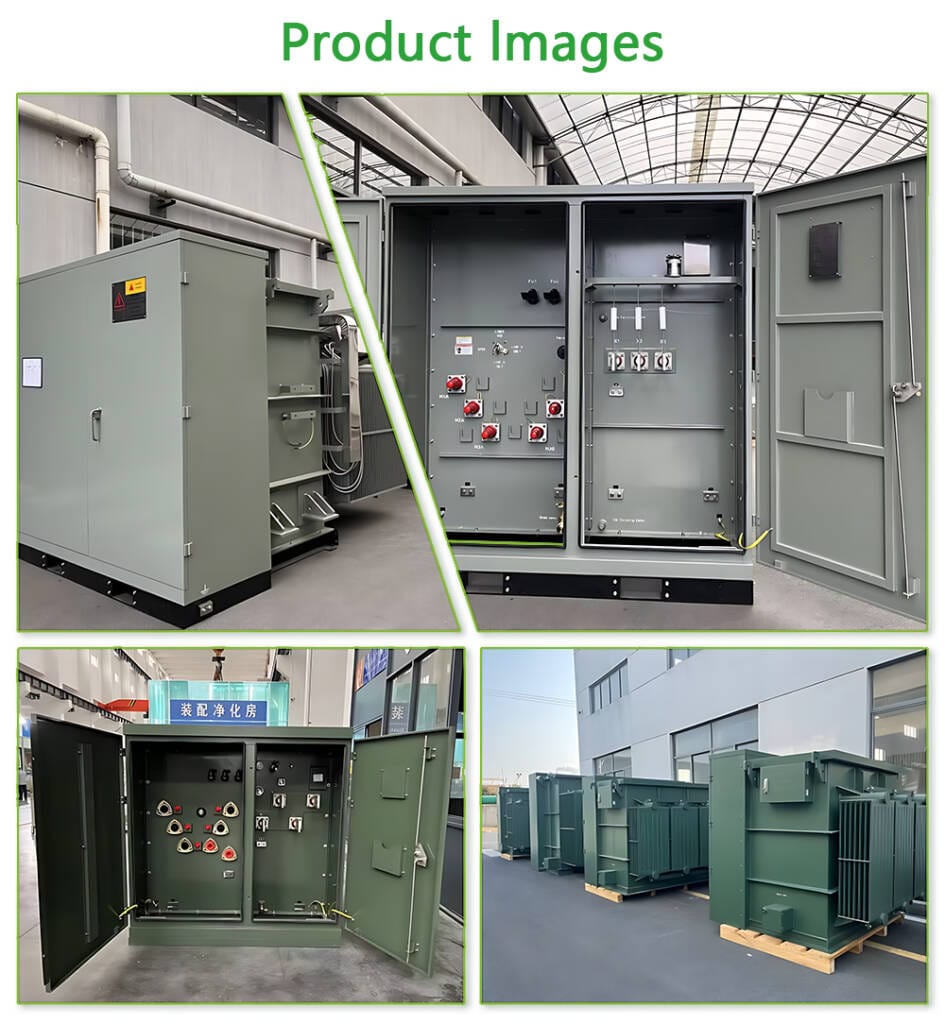
9.Cost and Lifecycle Considerations
While American box substationsoften cost less upfront, they require more frequent replacement or maintenance over their service life. European substations, though more expensive initially, offer lower lifecycle coststhrough reduced downtime, modular repairs, and longer operational stability.
For projects prioritizing long-term performance, sustainability, and safety compliance, the European type delivers a better return on investment (ROI).
Summary: Choosing the Right Type
In summary, the European Box Type Substation Transformerstands out for its safety, durability, modularity, and flexibility, making it ideal for industrial, commercial, and renewable energy projects that demand continuous, high-reliability operation.
Le American Box Type Substation Transformer, on the other hand, is preferred for compact urban or temporary installations, where fast deployment and low initial cost outweigh complex maintenance needs.
For power engineers and procurement managers, understanding these differences ensures that every substation investment is aligned with the project’s capacity, safety standards, maintenance strategy, and environmental conditions.
V. Advantages of European Box Type Substation Transformer
Le European Box Type Substation Transformerhas established itself as a leading solution for modern power distribution. Its combination of high performance, cost efficiency, robust safety, and flexible customizationmakes it the preferred choice for industrial plants, renewable energy projects, commercial complexes, and urban infrastructure. Below is a detailed breakdown of its key advantages.
1. Outstanding Performance
European box substations are engineered for high reliability and continuous operation under demanding conditions. All units comply with IEC 60076 standards to ensure international reliability.
Key performance advantages include:
- Stable Voltage and Load Handling:Efficient step-down from medium voltage (6–35kV) to low voltage (400/415V) with minimal energy loss.
- Low Heat and Noise:Optimized transformer design and compartmentalized layout reduce heat buildup and acoustic noise, extending service life.
- High Efficiency Transformers:Advanced core and winding designs minimize hysteresis and eddy current losses, improving energy efficiency and reducing operational costs.
- Environmental Resilience:IP54/IP65-rated enclosures protect against dust, moisture, and corrosion, ensuring reliable operation in deserts, coastal areas, or industrial environments.
This combination ensures consistent performance, even in high-demand industrial or renewable energy installations.
2. Cost Advantages and Lifecycle Efficiency
While the initial investment in European box-type substations may be higher than that of traditional or American-style compact units, their total lifecycle costis significantly lower:
- Reduced Installation Cost:Fully prefabricated and factory-tested units shorten on-site installation time and minimize civil works.
- Lower Maintenance Cost:Split-compartment design allows inspection or repair of individual sections without shutting down the entire system.
- Long Service Life:Typical operational lifespan of 25–30 years reduces replacement frequency and maximizes return on investment.
- Energy Savings:Efficient transformers and smart monitoring systems optimize power usage, reducing energy bills over time.
Overall, European box substations provide ROI élevé, combining upfront reliability with lower operational and maintenance expenses.
3. Superior Safety Design
Safety is a core advantage of the European box-type substation, making it suitable for critical installations:
- Compartmentalized Layout:High-voltage, transformer, and low-voltage sections are fully separated, preventing fault propagation.
- Advanced Protective Devices:Equipped with circuit breakers, fuses, lightning arresters, and relays for overload, short-circuit, and surge protection.
- Grounding and Fire Protection:Independent grounding for each compartment and fire-resistant enclosures minimize risks to personnel and equipment.
- Enhanced Environmental Protection:Metal-enclosed, sealed designs resist dust, moisture, and external mechanical damage.
These safety measures ensure maximum protection for operators, equipment, and downstream networks, which is especially critical in industrial and renewable energy applications.
4. Flexible Customization and Adaptability
European box substations are highly adaptable to different project requirements:
- Voltage and Capacity Options:Supports medium-voltage levels from 6kV to 35kV and low-voltage outputs from 400/415V, with transformer capacities ranging from 100kVA to 2500kVA or higher.
- Optional Features:Can include SCADA or IoT-enabled monitoring, capacitor banks, surge protection, and automation systems.
- Enclosure Design:Customizable for indoor or outdoor installation, environmental protection ratings, and local climate conditions.
- Future-Proof Expansion: Modular design allows upgrading or replacing individual components without overhauling the entire system.
This level of customization ensures that every European box-type substation can meet the precise needs of industrial plants, commercial complexes, solar or wind farms, and urban distribution networks.
5. Summary
Le European Box Type Substation Transformerdelivers a balanced combination of high performance, cost-effectiveness, robust safety, and versatile customization.
- Performance:Stable, reliable, and efficient energy transformation.
- Cost:Lower total lifecycle costs through reduced installation, maintenance, and energy expenses.
- Safety:Compartmentalized design with advanced protection minimizes risk and ensures operational continuity.
- Customization:Flexible voltage ratings, capacity, and monitoring options for diverse project requirements.
For project managers, EPC contractors, and industrial energy users, European box-type substations provide a future-proof, reliable, and efficient solutionfor modern power distribution challenges.

VI. Applications of Box Type Substation Transformer
Le European Box Type Substation Transformeris a modern, modular, and highly reliable power distribution solution. Its combination of high performance, safety, compact design, and customization capabilitymakes it ideal for a wide range of applications—from industrial plants and renewable energy projects to urban infrastructure and residential communities. Below is a detailed overview of its key applications, emphasizing both technical performance and business value.
1. Industrial Plants and Large-Scale Manufacturing Facilities
Industrial operations demand high-capacity, stable, and continuous power supplyfor heavy machinery, automated assembly lines, and critical production equipment. European box-type substations provide:
- High transformer capacities(up to 2500 kVA or higher) to handle peak load demands without voltage fluctuations.
- Redundant protective devices, including fuses, relays, and circuit breakers, minimizing downtime due to overloads or short circuits.
- Modular design, allowing maintenance or upgrades of specific compartments without shutting down the entire system, ensuring uninterrupted production
- Long-term reliability, reducing replacement costs and downtime.
Typical industries benefiting from European box-type substations include automotive factories, electronics manufacturing, chemical plants, metal processing facilities, and large logistics hubs.
2. Renewable Energy Projects (Solar PV and Wind Farms)
With the global shift toward renewable energy, distributed generation systemsrequire flexible and reliable substations. European box-type transformers are ideal for renewable applications because they provide:
- Efficient medium-voltage to low-voltage conversionto feed generated electricity into the grid safely and efficiently.
- Weather-resistant and durable enclosurescapable of withstanding extreme heat, humidity, dust, and salt-laden air.
- Smart monitoring integration, including SCADA or IoT systems, enabling real-time performance tracking, predictive maintenance, and energy management optimization.
- Scalable design, supporting phased expansions as additional PV panels or wind turbines are added.
They are widely used in utility-scale solar farms, onshore and offshore wind farms, hybrid renewable energy plants, and off-grid microgrids, ensuring both efficiency and reliability.
3. Commercial Complexes, Office Parks, and Urban Infrastructure
Urban and commercial power systems often face space limitations and strict safety requirements. European box-type substations address these challenges with:
- Compact and modular layout, fitting rooftops, basements, or narrow urban plots.
- Low-noise operation, suitable for office buildings, shopping malls, hotels, and hospitals.
- Advanced safety measures, including compartmentalization, fire-resistant enclosures, and independent grounding.
- Continuous operation capabilities, ensuring stable power for critical commercial systems like elevators, lighting, and HVAC.
They are ideal for smart city infrastructure, transportation hubs, commercial districts, and high-density office complexes.
4. Residential Communities and Smart Housing Projects
Modern residential areas and smart cities require safe, low-maintenance, and efficient power distribution. European box-type substations provide:
- Noise-free operation, making them suitable for suburban or urban neighborhoods.
- Advanced safety with separated high-voltage and low-voltage compartments, protecting residents and property.
- Integration with smart meters and energy management systems, supporting efficient electricity monitoring, load balancing, and peak shaving.
- Customizable enclosures, ensuring aesthetic integration into community layouts.
Common applications include gated communities, apartment complexes, high-rise residential towers, and mixed-use developments.
5. Critical Facilities: Hospitals, Data Centers, Airports, and Research Centers
Facilities with zero tolerance for downtimerequire highly reliable and redundant power systems. European box-type substations provide:
- High reliability and fault isolation, preventing single-point failures from affecting overall operations.
- Predictive maintenance capabilities, using integrated monitoring systems to detect early signs of equipment stress.
- Compatibility with backup systems, including UPS or emergency generators, ensuring uninterrupted power supply.
- Enhanced safety features, protecting sensitive equipment and personnel.
These features make European box-type substations ideal for hospitals, data centers, airports, research laboratories, and critical government facilities.
6. Temporary, Remote, and Construction Site Installations
European box-type substations are highly effective for temporary or remote power distribution, providing:
- Rapid deployment with minimal site preparation, reducing setup time and labor costs.
- Durability in harsh environments, including dust, extreme temperatures, and moisture exposure.
- Portability and scalability, allowing units to be relocated or upgraded as project requirements change.
Applications include construction sites, mining operations, oil & gas facilities, disaster recovery projects, and remote industrial installations.
7. Industrial Parks, Microgrids, and Smart Grid Applications
European box-type substations are increasingly used in industrial parks and decentralized energy networks, offering:
- Efficient power distribution across multiple facilities, reducing energy losses.
- Support for renewable microgrids, including solar PV, wind turbines, and battery storage.
- Smart monitoring and automation, allowing remote control and predictive maintenance for multiple units.
- Expandable modular design, accommodating future load growth without major infrastructure changes.
These capabilities make them essential for modern industrial parks, smart factories, and distributed energy networks.
Summary
European Box Type Substation Transformers are highly versatile, reliable, and cost-effectivesolutions for modern power distribution. Their broad applications include:
- Industrial plants and factories
- Renewable energy projects (solar and wind)
- Commercial complexes and urban infrastructure
- Residential communities and smart housing
- Critical facilities such as hospitals, airports, and data centers
- Temporary or remote installations
- Industrial parks, microgrids, and smart grids
By combining modular design, high performance, robust safety, cost-efficiency, and flexible customization, European box-type substations provide long-term reliability, reduced operational costs, and scalable energy solutions. They are ideal for project managers, EPC contractors, and industrial energy users seeking future-ready, efficient, and safe power distribution.
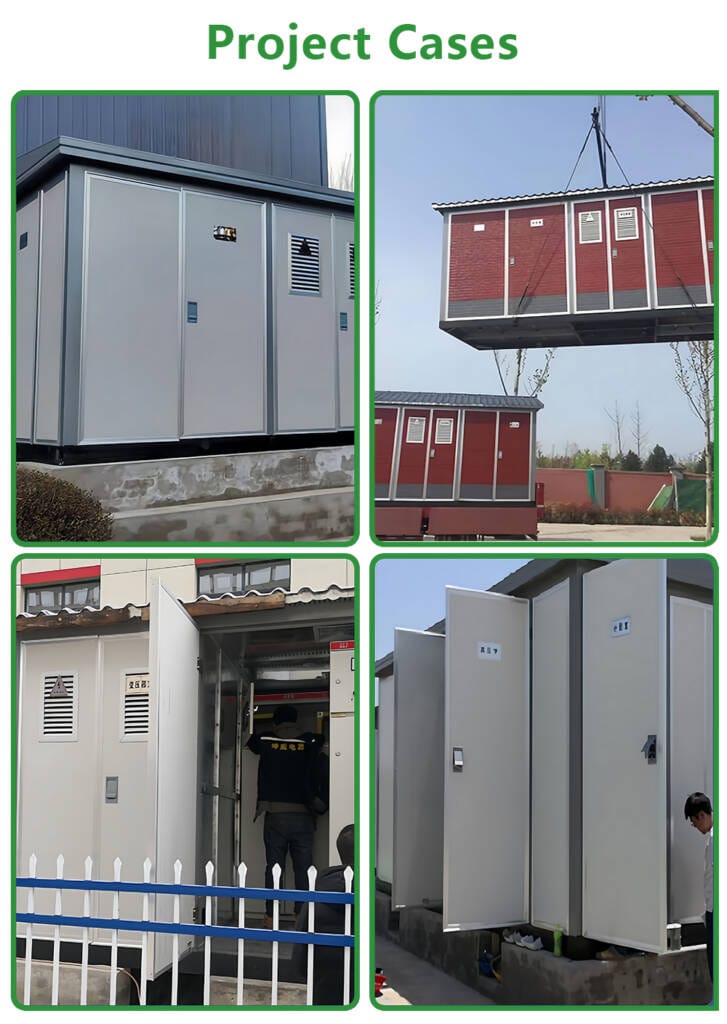
VII. Maintenance and Operation of European Box Type Substation Transformers
European Box Type Substation Transformers are engineered not only for high efficiency, reliability, and safety, but also for ease of operation and long-term maintenance. Proper maintenance ensures consistent power supply, reduced operational costs, extended service life, and compliance with safety standards, which are crucial for industrial, commercial, renewable energy, and urban infrastructure projects.
1. Modular Design Enhances Maintenance Efficiency
Le split-compartment modular designof European box-type substations separates the high-voltage, transformer, and low-voltage sections. This provides multiple advantages:
- Safe and isolated access: Each compartment can be inspected or serviced without shutting down the entire unit, reducing downtime.
- Targeted maintenance: Engineers can focus on specific sections, such as circuit breakers, protection relays, or transformer units, without affecting the rest of the system.
- Quick replacement and upgrades: Modular components can be replaced or upgraded individually, minimizing disruption and labor costs.
This design significantly improves operational efficiency, especially for facilities requiring 24/7 power supply, such as factories, hospitals, or data centers.
2. Routine Inspection and Monitoring
Effective operation relies on preventive and predictive maintenance. European box-type substations support both manual and automated monitoring, providing comprehensive system oversight:
- Visual inspection: Checking for dust accumulation, moisture ingress, corrosion, oil leaks, or physical damage.
- Thermal imaging: Detecting hotspots and abnormal temperature rises in transformers, busbars, or circuit breakers.
- Electrical testing: Insulation resistance, contact resistance, and functional testing of protective relays and breakers.
- Remote monitoring systems (SCADA/IoT): Real-time supervision of voltage, current, transformer temperature, load, and other critical parameters.
By combining these methods, operators can identify early signs of faults, prevent failures, and optimize maintenance schedules, thereby reducing costly downtime.
3. Transformer Unit Maintenance
European box-type substations can house dry-type or oil-immersed transformers, each with specific maintenance requirements:
Minimal maintenance: routine visual inspections, cleaning dust or debris, checking for moisture or discoloration.
Periodic testing of insulation and winding resistance ensures continued efficiency.
Regular oil quality testing, including dielectric strength, moisture content, and acidity.
Monitoring for oil leaks or abnormal pressurein sealed tanks.
Cooling system maintenance: fans, radiators, and natural ventilation systems must be cleaned and checked regularly.
Well-maintained transformer units deliver stable voltage output, longer operational life, and lower energy losses.
4. High-Voltage and Low-Voltage Component Maintenance
Maintenance of other critical compartments ensures system reliability and safety:
- High-voltage compartment: Includes circuit breakers, disconnect switches, fuses, lightning arresters, and protection relays. Modular isolation allows safe inspection and maintenancewithout powering down the entire substation.
- Low-voltage compartment: Contains busbars, distribution breakers, meters, and monitoring devices. Easy accessibility ensures quick troubleshooting and component replacement.
Regular maintenance of both compartments prevents faults, protects equipment, and ensures uninterrupted power supply.
5. Safety During Maintenance
European box-type substations prioritize operator safetyduring all maintenance procedures:
- Compartmentalized metal enclosureswith independent grounding prevent accidental contact with live parts.
- Lockable access doors and interlocksrestrict unauthorized entry.
- Fire-resistant materialsand pressure relief devices reduce the risk of fire or explosion.
Compliance with IEC, EN, and local safety standards, ensuring a safe work environment during inspection, cleaning, or repair.
These features significantly reduce operational risks, especially in high-demand or critical environments.
6. Scheduled Maintenance and Lifecycle Management
A structured maintenance program maximizes reliability and ROI:
- Preventive maintenance: Monthly or quarterly inspections, cleaning, lubrication, and verification of protective devices.
- Predictive maintenance: Using real-time monitoring and analytics to identify early signs of wear, thermal stress, or load imbalance.
- Lifecycle management: Modular design allows component replacement or upgrades without replacing the entire substation. Proper planning ensures 25–30 years of operational life.
Documentation and logging: Maintaining detailed records of inspections, testing, and repairs aids trend analysis, fault diagnosis, and regulatory compliance.
7. Operational Best Practices
To ensure optimal performance and longevity:
- Load management: Avoid overloading; monitor real-time current and voltage through integrated monitoring systems.
- Environmental control: Ensure ventilation, protection from dust, moisture, corrosive agents, and temperature extremes.
- Training personnel: Skilled operators reduce human error and enhance operational safety.
- Remote supervision: Leverage SCADA or IoT systems for predictive maintenance, early warning, and load optimization.
8. Cost and Performance Benefits of Proper Maintenance
Regular, structured maintenance translates into tangible financial and operational benefits:
- Reduced downtime: Quick fault detection and compartmentalized repair minimize service interruptions.
- Lower operational costs: Early problem detection reduces major repair expenses.
- Extended equipment life: Proper care prolongs transformer and component lifespan, delaying replacement costs.
- Enhanced efficiency: Well-maintained transformers and switchgear operate at peak efficiency, reducing energy losses.
These advantages make European box-type substations a smart long-term investmentfor any facility.
Summary
Therefore, European Box Type Substation Transformers deliver efficient operation, straightforward maintenance, and long-term reliability. Their modular design, smart monitoring systems, safety features, and structured maintenance protocols ensure:
- Safe and efficient routine inspections
- Early fault detection and preventive repair
- Reduced downtime and maintenance costs
- Extended service life and maximized ROI
For industrial plants, renewable energy projects, urban infrastructure, and critical facilities, a robust maintenance strategy ensures that European box-type substations continue to deliver safe, efficient, and uninterrupted power for decades.

VIII. Why European Box Type Substation Transformers Are the Smart Choice
In modern power distribution systems, selecting the right transformer is critical for operational efficiency, cost savings, and long-term reliability. European Box Type Substation Transformers (BSTs)have proven to be a superior solutionfor industrial, commercial, renewable energy, and urban infrastructure projects due to their unique combination of performance, safety, cost-effectiveness, modularity, and maintainability.
1. Unmatched Performance for Demanding Applications
As a result of their robust design, European box-type substations reliably support continuous, high-capacity operation across a wide range of conditions.:
- Stable and Efficient Power Delivery:These transformers provide consistent voltage output with minimal energy loss, ensuring sensitive equipment operates safely and efficiently.
- High Load Capacity:Capable of handling industrial-grade loads up to 2500 kVA or more, they are suitable for heavy machinery, production lines, and large commercial facilities.
- Environmental Resilience:With high IP ratings (IP54/IP65) and robust enclosures, they resist dust, moisture, extreme temperatures, and corrosion, making them ideal for both indoor and outdoor installations.
- Low Noise and Heat Emission:Advanced transformer and compartment design reduce operational noise and heat, creating a safer and more comfortable environment for personnel.
These performance attributes make European BSTs a reliable backbone for continuous industrial, commercial, and renewable energy operations.
2. Cost Advantages and Total Lifecycle Savings
While European BSTs may require a slightly higher upfront investment than some traditional or compact units, their total cost of ownership (TCO)is significantly lower:
- Reduced Installation Costs: Factory-assembled, fully tested units minimize on-site work, shorten construction timelines, and lower labor expenses.
- Lower Maintenance Costs: Modular compartment design allows component-specific maintenance without full system shutdown, reducing operational interruptions.
- Energy Efficiency: Optimized transformer cores and winding designs reduce losses, translating into substantial energy savings over time.
- Long Lifespan: Typical operational life of 25–30 years ensures long-term ROI and delays replacement costs.
This makes European BSTs a cost-effective investment, delivering both immediate and long-term financial benefits.
3. Comprehensive Safety and Reliability Features
Safety is a core advantage of European box-type substations:
- Compartmentalized Layout:High-voltage, transformer, and low-voltage sections are separated, preventing fault propagation and minimizing risk to operators.
- Advanced Protective Devices:Circuit breakers, fuses, surge arresters, and relays provide protection against overloads, short circuits, and lightning strikes.
- Fire-Resistant Materials and Pressure Relief Systems:Reduce risk of fire or explosion during abnormal operating conditions.
- Compliance with International Standards:Designed to meet IEC, EN, and local safety codes, ensuring maximum reliability and regulatory compliance.
These safety features protect both personnel and equipment, which is especially critical for industrial, commercial, and critical infrastructure applications.
4. Flexible Customization to Fit Every Project
European box-type substations are highly adaptable to specific project requirements:
- Voltage and Capacity Options: Medium-voltage levels (6–35 kV) and low-voltage outputs (400/415 V) with capacities ranging from 100 kVA to 2500 kVA or higher.
- Optional Features: Integration with SCADA, IoT monitoring, automation systems, capacitor banks, and surge protection.
- Modular and Scalable Design: Allows future expansion or upgrade without replacing the entire unit.
- Environmental and Aesthetic Adaptations: Custom enclosures for indoor/outdoor installation, urban integration, and local climate conditions.
This flexibility ensures that every European BST can be tailored to meet the exact technical, environmental, and budget requirementsof the project.
5. Efficient Maintenance and Operation for Long-Term Reliability
European BSTs are designed for simplified operation and maintenance, which is key to minimizing downtime and operational costs:
- Modular Compartments: High-voltage, transformer, and low-voltage sections can be serviced individually without interrupting power supply.
- Predictive and Preventive Maintenance: Integrated SCADA and IoT systems allow real-time monitoring of load, temperature, and voltage anomalies, enabling early fault detection.
- Routine Maintenance: Regular inspections of insulation, busbars, cooling systems, protective devices, and transformer oil or dry-type components extend service life.
- Operational Best Practices: Load management, environmental control, record keeping, and operator training ensure consistent performance and safety.
Well-maintained European BSTs offer 25–30 years of uninterrupted, reliable service, making them a strategic long-term investment.
6. Versatile Applications Across Industries
European box-type substations are suitable for:
- Industrial Plants and Factories:High-capacity, reliable power for manufacturing, assembly lines, and heavy machinery.
- Renewable Energy Projects:Solar farms, wind farms, hybrid microgrids with scalable, resilient distribution.
- Commercial Complexes and Urban Infrastructure:Compact, low-noise, and safe installations for offices, malls, hospitals, and transport hubs.
- Residential Communities and Smart Cities:Low-maintenance, quiet, and aesthetically adaptable for modern residential areas.
- Critical Facilities:Hospitals, data centers, airports, and research labs requiring continuous power.
- Temporary or Remote Installations:Construction sites, mining operations, and remote industrial projects.
- Industrial Parks and Microgrids:Efficient energy distribution, smart control, and modular expansion.

Final Thoughts
Investing in European Box Type Substation Transformersmeans choosing a solution that maximizes performance, minimizes costs, ensures safety, and offers long-term reliability. Their modular design, customizable features, and easy maintenancemake them a smart choice for any industrial, commercial, renewable, or urban energy project.
By selecting European BSTs, project managers, EPC contractors, and industrial energy users can achieve:
- Stable, efficient, and safe power distribution
- Reduced installation, operational, and maintenance costs
- Enhanced reliability and long-term ROI
- Flexibility to adapt to evolving energy demands and technologies
If you are planning a new industrial, commercial, or renewable energy project, or need to upgrade your existing power distribution system, contact us today to learn how our European Box Type Substation Transformers can deliver reliable, efficient, and future-ready power solutions tailored to your needs.

